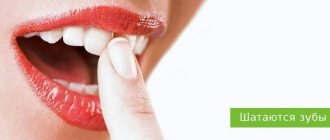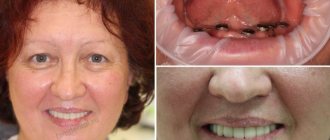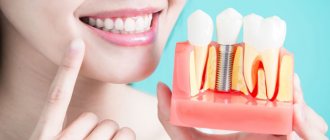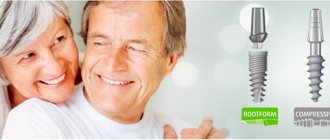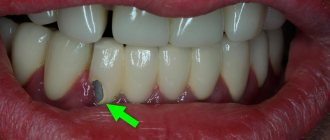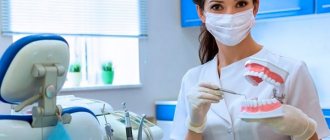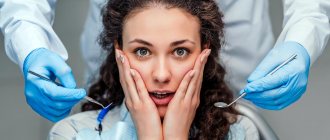Excessive tooth mobility is a common symptom indicating the development of severe dental diseases.
Unfortunately, many patients underestimate the danger of this pathology and postpone visiting the doctor until the last minute, depriving themselves of the opportunity to receive timely dental care. Meanwhile, in the absence of treatment, tooth mobility progresses and becomes irreversible. It is for this reason that any delay in starting restorative therapy significantly reduces the chances of maintaining the integrity of the dentition.
Causes of tooth mobility
Depending on the causes of occurrence, there are two types of tooth mobility:
- pathological;
- physiological.
Physiological mobility
Physiological mobility is determined by the need to evenly distribute the load on the dentofacial apparatus during chewing food. The amplitude of tooth movement is so small that the displacement cannot be noticed without additional research. The only evidence of physiological mobility is the formation of small ground areas at the lateral contact points of the teeth.
Pathological mobility
Pathological mobility is spoken of in cases where a change in the position of the teeth in the alveolar sockets becomes visually discernible. To describe the symptomatic picture of the pathology, the so-called Miller scale is used. The level of mobility is measured in points (from 0 to 3), with the upper value implying the ability of the tooth to move in all directions (including vertical).
Causes of pathological mobility
The causes of pathological tooth mobility can be:
- poor hygiene, the formation of an internal environment in the mouth that is favorable for the proliferation of pathogenic organisms, the appearance of soft and dense dental plaque;
- incorrect selection of individual hygiene products and devices, their illiterate use;
- pathological bite or unnatural position of individual teeth;
- endocrine disruptions in the body;
- untimely installation of prosthetic devices or implants after the loss of individual teeth;
- mistakes made by inexperienced dentists when providing certain dental services;
- anomalies in the structure of the dentofacial apparatus, too short frenulum of the tongue and lips;
- atrophy of the alveolar processes;
- inflammatory damage to the gum tissue, leading to dysfunction of the ligamentous apparatus of the teeth;
- injuries.
Clinic doctors
When excessive tooth mobility occurs, this indicates certain dental problems. If measures are not taken, not only cosmetic disorders and problems with chewing food are inevitable, but also complete loss of teeth.
Why does tooth mobility occur?
Human teeth are not firmly fixed in the sockets. A little physiological mobility is needed to evenly distribute the chewing load. It is completely invisible and can only be detected through special research. But sometimes pathological mobility of teeth is observed when they move to the sides, and in the most severe cases - vertically and around their axis.
Certain factors contribute to this:
- poor oral hygiene – accumulations of tartar push the gums away from the tooth;
- incorrect choice or incorrect use of dental care products;
- anomalies of the bite or individual teeth;
- gum disease – tooth mobility can be a consequence of periodontitis and periodontal disease;
- lack of timely prosthetics;
- diseases of the endocrine system;
- jaw injuries;
- unqualified actions of the dentist.
Regardless of the cause of tooth mobility, treatment should begin as quickly as possible.
Degrees of tooth mobility
The classification of tooth mobility includes four stages:
- Some teeth sway slightly in relation to their neighbors, while the amplitude of their movement does not exceed 1 mm.
- The teeth are loose in all directions with an amplitude of just over 1mm.
- Teeth move in any direction, including vertically.
- With the fourth degree of tooth mobility, rotation around its axis is added to everything else.
Is it possible to cure tooth mobility?
Since the problem is usually associated with the destruction of the ligaments that hold the tooth in the socket, therapy is aimed at strengthening it. Early determination of tooth mobility gives a high chance of recovery.
Complex treatment includes drug therapy - taking antibiotics, vitamins, drugs to increase immunity and fixing loose teeth.
To block tooth movement in dentistry, the following are used:
- Tires. Healthy and loose teeth are connected to each other with fiberglass or aramid thread, which is attached to the back surfaces using composite filling materials.
- Clasp dentures. This method of treating tooth mobility is relevant only in case of lack of teeth. After all, first of all, it is intended to replace such defects. The design consists of a plastic gum, crowns and an arched metal base. The prosthesis is held on the teeth using hooks, which ensures their stable condition.
In combination with drug treatment for tooth mobility, these techniques provide excellent results.
How to prevent tooth mobility
Preventing tooth mobility is not particularly difficult. To reduce the risk of loosening:
- to refuse from bad habits;
- Healthy food;
- brush your teeth thoroughly using paste, brush, floss and mouthwash;
- visit the dentist regularly;
- do professional oral hygiene.
And, of course, you should not delay visiting a doctor if problems arise, because the cost of treating tooth mobility is much higher than preventive procedures.
Classification of tooth mobility
In modern dental practice, to determine the degree of unnatural mobility of teeth, the classification developed by Honored Scientist of Russia David Abramovich Entin is most often used.
According to this typology, the following levels of mobility are distinguished:
- I degree (instability of position in relation to the coronal parts of adjacent teeth in the oral-vestibular or bucco-lingual directions, amplitude of movement less than 1 mm);
- II degree (mobility in similar directions with an amplitude of more than 1 mm, the appearance of movements in the distal-palatal direction);
- III degree (ability to move in all directions, including vertical);
- IV degree (adding rotational movements of the diseased tooth around its own axis).
Prevention measures
To prevent your teeth from becoming too loose, you need to maintain good oral hygiene. If you make it a habit to visit the dentist once every six months, the doctor will definitely tell you what measures will help strengthen your gums. The general rules are:
- ensure optimal load on the teeth - add hard vegetables and fruits to the diet;
- create a diet containing microelements and vitamins necessary for teeth;
- carry out professional cleaning of the oral cavity - remove stones and plaque.
In addition, regular consultation examinations will allow the doctor to detect the disease at an early stage.
Add a comment
Leave your comment
Treatment of unwanted tooth mobility
The treatment program for tooth mobility necessarily includes measures aimed at combating the underlying disease that provoked the development of the pathological process.
Otherwise, the scheme of therapeutic measures is individual in nature and can be supplemented by:
- carrying out professional hygienic treatment of teeth;
- selection of the most suitable individual hygiene products, devices for comprehensive dental care, teaching the patient the basics of their use;
- a set of measures aimed at eliminating malocclusion, the necessary orthodontic or surgical treatment;
- surgical or conservative treatment of periodontitis and other dental diseases.
If necessary, the doctor may decide to carry out a set of measures aimed at preventing further loosening of the teeth. Preference is given to splinting methods using removable and non-removable splinting structures.
The effectiveness of treatment depends directly on both the professionalism of the attending physician and the timeliness of therapeutic measures. That is why the detection of tooth mobility at any stage of the development of the pathological process is an absolute basis for contacting a doctor and receiving qualified dental care.
Physiological and pathological mobility
Physiological tooth mobility is invisible to you, but it is activated whenever you eat solid food. This is due to the presence of specific shock absorption of the ligamentous apparatus, due to which the chewing load is distributed evenly across the jaws. In the absence of such a reflex, our teeth would very quickly deteriorate and begin to collapse. Especially those who, by definition, have to withstand the majority of the functional load. Noticeable tooth mobility is almost always pathological in nature. Most often, the appearance of such a symptom is associated with the development of periodontitis - an inflammatory process in periodontal tissues, due to which gradual destruction of the ligamentous apparatus and jaw bones occurs. Periodontitis usually has an infectious origin, and it must be treated urgently, at the first detection of its symptoms. If there are pathological causes, tooth mobility is classified according to severity. In the two early stages of the development of the symptom, the teeth become loose in a forward and backward direction, and the range of movements varies in intensity. At the third stage, the tooth also begins to move laterally, and at the final, fourth stage, it can rotate around its own axis. Unfortunately, the final stage of tooth mobility is a direct indication for their removal. In the first stages of loosening, treatment is possible, but it is lengthy and quite complex.
Dental treatment at an affordable cost can be successfully carried out in our dental clinic of Dr. Granov.
Professional help from specialists is mandatory in the matter of eliminating tooth mobility.
First of all, it is necessary to regularly seek preventive examinations to prevent common diseases of the oral tissues.
Leave your phone number. The clinic administrator will call you back.
By leaving a request on the site, you consent to the processing of personal data
Make an appointment
Initial consultation with a dentist
For free!
Functional traumatic overload of the periodontium
-occupies a special place among local causes in the etiology and pathogenesis of periodontal diseases. When chewing and swallowing, at the moment of closure of the dentition, the periodontium of each tooth perceives a force load, which under normal conditions is absorbed by special periodontal devices (cemento-alveolar, interdental fibers, etc.). Then it is transformed and transmitted to the bone structures of the jaws, the temporomandibular joint and the skull. This physiological load helps normalize trophism and metabolism, stimulates the processes of growth and development.
With pathological processes in the periodontium caused by common causes (vitaminosis, diabetes and other disorders of endocrine regulation, diseases of the gastrointestinal tract, cardiovascular system and nervous systems, etc.), the resistance of periodontal tissues decreases.
As a result of weakening of the periodontium, the usual occlusal load begins to exceed the tolerance of its structures and turns from a factor stimulating development into a traumatic one, disrupting the trophism of the periodontium and destroying its tissues. Traumatic occlusion occurs, which subsequently plays a leading role in the course of this disease.
The term “traumatic occlusion” was proposed by PR Stillman in 1919. Other terms have been proposed to characterize and define periodontal overload:
- “traumatic articulation”
- “functional traumatism”
- “pathological occlusion”
- “functional traumatic overload of teeth”, etc.
According to the mechanism of development, three types of traumatic occlusion are distinguished:
— Primary
— Secondary
— Combined
Primary traumatic occlusion develops against the background of unaffected periodontium as a result of the action of an occlusal load that is excessive in magnitude and/or direction.
Thus, primary traumatic overload of healthy periodontium can occur due to excessive magnitude, abnormal direction and duration of action of the occlusal functional load and steam function of the masticatory, facial muscles and tongue. More often than not, overload is caused by the simultaneous action of several causes.
Secondary traumatic occlusion:
Its pathogenesis is based on pathological changes in periodontal tissue. At the same time, degenerative and inflammatory processes develop in the supporting tissues of the teeth throughout the entire dentition, which are accompanied by:
1). resorption of bone tissue of the alveolar process.
2). Gingivitis.
3). destruction of the periodontium with the formation of a pocket.
4). suppuration from it.
Resorption of the bone tissue of the sockets leads to a disruption of the normal biological patterns of the structure and function of the periodontium. From this moment on, a radical change occurs in the biomechanical relationship between teeth and surrounding tissues.
Thus, a change in the ratio of the extra- and inside the alveolar part of the tooth is one of the pathogenetic mechanisms in the development of traumatic occlusion.
The clinical picture of secondary traumatic occlusion is diverse and depends on the patient’s age, the form of the underlying disease (periodontal disease, periodontitis), its severity and stage of development, the presence of dentition defects, malocclusion or tooth position, pathological abrasion and other traumatic factors.
If for primary traumatic occlusion orthopedic intervention is sufficient, then for secondary occlusion complex therapeutic (local and general), surgical and orthopedic treatment is required. The prognosis also varies. In case of primary traumatic occlusion, after eliminating the overload of the teeth in all periodontal tissues, reparative processes occur.
